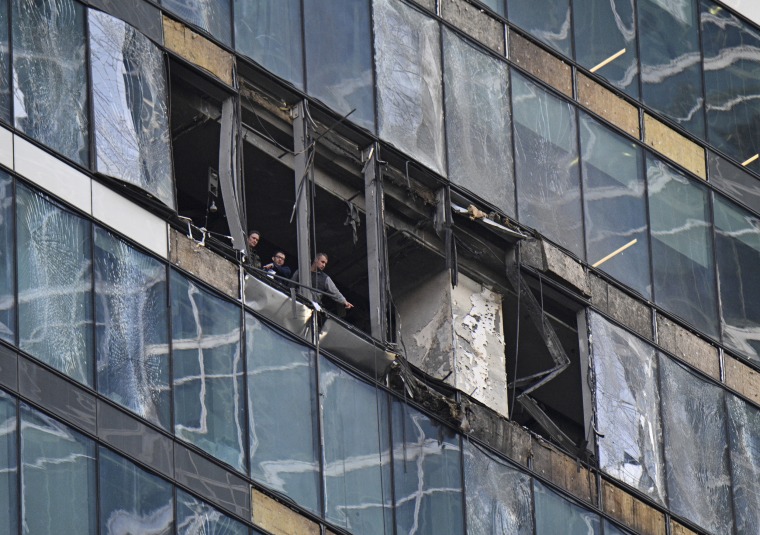Ukraine’s counteroffensive may be struggling on the ground, but it is increasingly taking the fight to Russia by air — and by sea.
In recent weeks, a spate of attacks on high-profile targets have either been acknowledged by or linked to Kyiv. All have also involved the use of either aerial or sea drones, signaling an apparent shift in Ukraine’s effort to wear its invader down.
Unable to overcome Russia’s battlefield defenses so far, Ukraine appears to be turning to its own campaign of attrition that includes deploying new weapons in its vow to see the war “returning” to Russia.
Doubling down on drones
On Friday morning, images of a damaged Russian naval ship limping back to port spread across social media. Russia acknowledged the attack, but not the damage.
A day later, a Russian oil tanker was targeted near a strategic bridge in the Kerch Strait that links Russia to the annexed Crimean Peninsula. This time, Russian officials called it a “terrorist attack” on a civilian vessel, acknowledging the damage.
On both occasions Ukraine’s security service let it be known that it was behind the attack, even sharing video from onboard naval drones packed with pounds of explosives as they approached and hit the ships.
The Russian-built bridge spanning the Kerch Strait, a pet project of President Vladimir Putin that is considered illegal by Ukraine, was also targeted by sea drones last month.
And the attacks at sea came as the Russian capital has been targeted by waves of aerial drones. While authorities said all attacks were repelled — including a new assault early Wednesday — several office towers have been damaged, while the frequency and relative ease with which the drones continue to penetrate Moscow’s air space have left many residents with a sense of unease.
These setbacks for the Kremlin contrast with action on the ground, where Ukraine’s counteroffensive, launched in June, has been slower than expected after Russian forces dug into heavily mined defense lines.
With its conventional forces fixed and without aerial or naval supremacy, the drones are “really the only way that Ukraine can strike back,” Mark Cancian, a retired Marine colonel and senior adviser at the Center for Strategic and International Studies, a national security think tank, told NBC News.
Why sea drones?
While Russia has long assaulted Ukrainian cities with Iranian-supplied drones and Ukraine has fought back with its own aerial drone attacks, sea drones are emerging as a new and strong capability for Kyiv to challenge Moscow’s maritime dominance, analysts said.
There is little publicly available information about them, Cancian said, but they are probably “an indigenous system that was helped by the U.S. and the West.”
The naval drones appear to be fairly small and ride low to the surface, making them hard to detect, he said. Like aerial drones, they are also unmanned, meaning there is no risk of personnel loss — but unlike the unmanned aerial vehicles, they can carry a much heavier load of explosives, he added, making them a more potent weapon.
The drones also appear to be composed of components that are readily commercially available and not hard to procure, involving a propulsion system derived from a civilian jet ski and guidance that seems to rely on satellite communications, said Sidharth Kaushal, a research fellow in sea power at the London-based Royal United Services Institute.
Like aerial drones, they can also be quite cost-effective, he said. “So even if you lose a few, but you destroy an expensive warship or damage it, the model pays for itself.”
While Russia has taken countermeasures against such drones, including physical barriers and nets at the entrances to key ports, the longer range Ukraine is now displaying with naval attacks stretches defenses across a much wider area, which includes not just Crimean, but also domestic ports, Kaushal said.
A ‘psychological effect?’
The recent sea drone attacks are in many ways a continuation of the efforts Ukraine appears to have first started late last year, with Cancian describing them as “an expansion of that capability.”
Should Ukraine start to mass produce and launch its sea drones at Russian ships and ports in incessant waves, Moscow could be left scrambling, said Ben Caves, a defense and security expert at Rand Europe, a not-for-profit research institute. The sheer number could overwhelm Russian defenses and force Moscow to use much more expensive ammunition and other valuable resources to take out volleys of drones coming at its naval assets, he said.

Last week, President Volodymyr Zelenskyy vowed to return the war to Russia — “to its symbolic centers and military bases.” He also warned in an interview Sunday that Russia could be left “with no ships” by the end of the war if it continues to attack Ukrainian ports.
The country’s key Black Sea ports have been repeatedly bombed by Russia since it pulled out of a United Nations-brokered deal that allowed Kyiv to still export its grain, crucial to the global food supply.
The sea drone attacks last week showed that Kyiv is getting more audacious in its ability to launch these weapons far from within its territory, Caves added, and it’s bound to have a psychological effect on Russia.
Putin, he said, has claimed military superiority, but appears unable to defend “against these very small projected forces that are able to sneak behind the lines.”
For months, military analysts have said the Kremlin has been settling in for a long war, hoping that the war of attrition will favor Russia by exhausting Ukraine’s human, economic and military potential.
“There is a perception in Russia that time is on their side and they only need to wait this out,” Kaushal said.
But Ukraine has been trying to disabuse them of this, he added, on the ground and with drones in the air but now increasingly — at sea, by demonstrating that as the war wears on, Russia will also bear the brunt.
“It is a very useful thing for the Ukrainians to demonstrate,” Kaushal said. “That’s the more long-term goal.”















+ There are no comments
Add yours